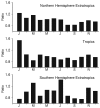Seasonality of Kawasaki disease: a global perspective
- PMID: 24058585
- PMCID: PMC3776809
- DOI: 10.1371/journal.pone.0074529
Seasonality of Kawasaki disease: a global perspective
Abstract
Background: Understanding global seasonal patterns of Kawasaki disease (KD) may provide insight into the etiology of this vasculitis that is now the most common cause of acquired heart disease in children in developed countries worldwide.
Methods: Data from 1970-2012 from 25 countries distributed over the globe were analyzed for seasonality. The number of KD cases from each location was normalized to minimize the influence of greater numbers from certain locations. The presence of seasonal variation of KD at the individual locations was evaluated using three different tests: time series modeling, spectral analysis, and a Monte Carlo technique.
Results: A defined seasonal structure emerged demonstrating broad coherence in fluctuations in KD cases across the Northern Hemisphere extra-tropical latitudes. In the extra-tropical latitudes of the Northern Hemisphere, KD case numbers were highest in January through March and approximately 40% higher than in the months of lowest case numbers from August through October. Datasets were much sparser in the tropics and the Southern Hemisphere extra-tropics and statistical significance of the seasonality tests was weak, but suggested a maximum in May through June, with approximately 30% higher number of cases than in the least active months of February, March and October. The seasonal pattern in the Northern Hemisphere extra-tropics was consistent across the first and second halves of the sample period.
Conclusion: Using the first global KD time series, analysis of sites located in the Northern Hemisphere extra-tropics revealed statistically significant and consistent seasonal fluctuations in KD case numbers with high numbers in winter and low numbers in late summer and fall. Neither the tropics nor the Southern Hemisphere extra-tropics registered a statistically significant aggregate seasonal cycle. These data suggest a seasonal exposure to a KD agent that operates over large geographic regions and is concentrated during winter months in the Northern Hemisphere extra-tropics.
Conflict of interest statement
Figures




References
-
- Rowley AH, Baker SC, Orenstein JM, Shulman ST (2008) Searching for the cause of Kawasaki disease--cytoplasmic inclusion bodies provide new insight. Nat Rev Microbiol 6: 394-401. doi:10.1038/nrmicro1853. PubMed: 18364728. - DOI - PMC - PubMed
-
- Yanagawa H, Yashiro M, Nakamura Y, Kawasaki T, Kato H (1995) Results of 12 nationwide epidemiological incidence surveys of Kawasaki disease in Japan. Arch Pediatr Adolesc Med 149: 779-783. doi:10.1001/archpedi.1995.02170200069011. PubMed: 7795769. - DOI - PubMed
-
- Hata A, Onouchi Y (2009) Susceptibility genes for Kawasaki disease: toward implementation of personalized medicine. J Hum Genet 54: 67-73. doi:10.1038/jhg.2008.9. PubMed: 19158812. - DOI - PubMed
-
- Onouchi Y (2009) Molecular genetics of Kawasaki disease. Pediatr Res 65: 46R-54R. doi:10.1203/PDR.0b013e31819dba60. PubMed: 19190534. - DOI - PubMed
Publication types
MeSH terms
Grants and funding
LinkOut - more resources
Full Text Sources
Other Literature Sources
Medical

